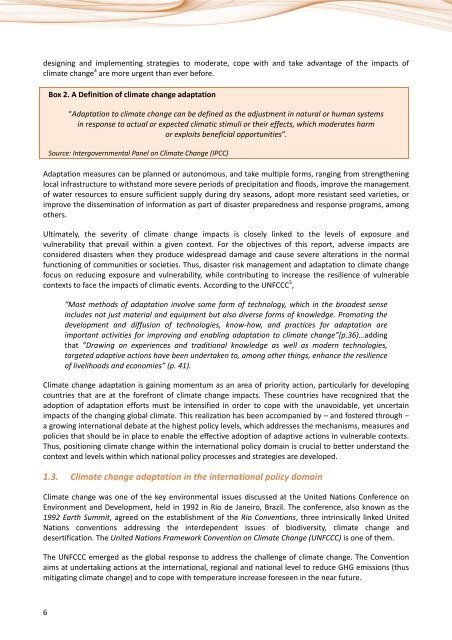Information and communication technologies (ICTs) and ... - ITU
Information and communication technologies (ICTs) and ... - ITU
Information and communication technologies (ICTs) and ... - ITU
You also want an ePaper? Increase the reach of your titles
YUMPU automatically turns print PDFs into web optimized ePapers that Google loves.
designing <strong>and</strong> implementing strategies to moderate, cope with <strong>and</strong> take advantage of the impacts of<br />
climate change 4 are more urgent than ever before.<br />
Box 2. A Definition of climate change adaptation<br />
“Adaptation to climate change can be defined as the adjustment in natural or human systems<br />
in response to actual or expected climatic stimuli or their effects, which moderates harm<br />
or exploits beneficial opportunities”.<br />
Source: Intergovernmental Panel on Climate Change (IPCC)<br />
Adaptation measures can be planned or autonomous, <strong>and</strong> take multiple forms, ranging from strengthening<br />
local infrastructure to withst<strong>and</strong> more severe periods of precipitation <strong>and</strong> floods, improve the management<br />
of water resources to ensure sufficient supply during dry seasons, adopt more resistant seed varieties, or<br />
improve the dissemination of information as part of disaster preparedness <strong>and</strong> response programs, among<br />
others.<br />
Ultimately, the severity of climate change impacts is closely linked to the levels of exposure <strong>and</strong><br />
vulnerability that prevail within a given context. For the objectives of this report, adverse impacts are<br />
considered disasters when they produce widespread damage <strong>and</strong> cause severe alterations in the normal<br />
functioning of communities or societies. Thus, disaster risk management <strong>and</strong> adaptation to climate change<br />
focus on reducing exposure <strong>and</strong> vulnerability, while contributing to increase the resilience of vulnerable<br />
contexts to face the impacts of climatic events. According to the UNFCCC 5 ,<br />
“Most methods of adaptation involve some form of technology, which in the broadest sense<br />
includes not just material <strong>and</strong> equipment but also diverse forms of knowledge. Promoting the<br />
development <strong>and</strong> diffusion of <strong>technologies</strong>, know-how, <strong>and</strong> practices for adaptation are<br />
important activities for improving <strong>and</strong> enabling adaptation to climate change”(p.36)…adding<br />
that ”Drawing on experiences <strong>and</strong> traditional knowledge as well as modern <strong>technologies</strong>,<br />
targeted adaptive actions have been undertaken to, among other things, enhance the resilience<br />
of livelihoods <strong>and</strong> economies” (p. 41).<br />
Climate change adaptation is gaining momentum as an area of priority action, particularly for developing<br />
countries that are at the forefront of climate change impacts. These countries have recognized that the<br />
adoption of adaptation efforts must be intensified in order to cope with the unavoidable, yet uncertain<br />
impacts of the changing global climate. This realization has been accompanied by – <strong>and</strong> fostered through −<br />
a growing international debate at the highest policy levels, which addresses the mechanisms, measures <strong>and</strong><br />
policies that should be in place to enable the effective adoption of adaptive actions in vulnerable contexts.<br />
Thus, positioning climate change within the international policy domain is crucial to better underst<strong>and</strong> the<br />
context <strong>and</strong> levels within which national policy processes <strong>and</strong> strategies are developed.<br />
1.3. Climate change adaptation in the international policy domain<br />
Climate change was one of the key environmental issues discussed at the United Nations Conference on<br />
Environment <strong>and</strong> Development, held in 1992 in Rio de Janeiro, Brazil. The conference, also known as the<br />
1992 Earth Summit, agreed on the establishment of the Rio Conventions, three intrinsically linked United<br />
Nations conventions addressing the interdependent issues of biodiversity, climate change <strong>and</strong><br />
desertification. The United Nations Framework Convention on Climate Change (UNFCCC) is one of them.<br />
The UNFCCC emerged as the global response to address the challenge of climate change. The Convention<br />
aims at undertaking actions at the international, regional <strong>and</strong> national level to reduce GHG emissions (thus<br />
mitigating climate change) <strong>and</strong> to cope with temperature increase foreseen in the near future.<br />
6

















